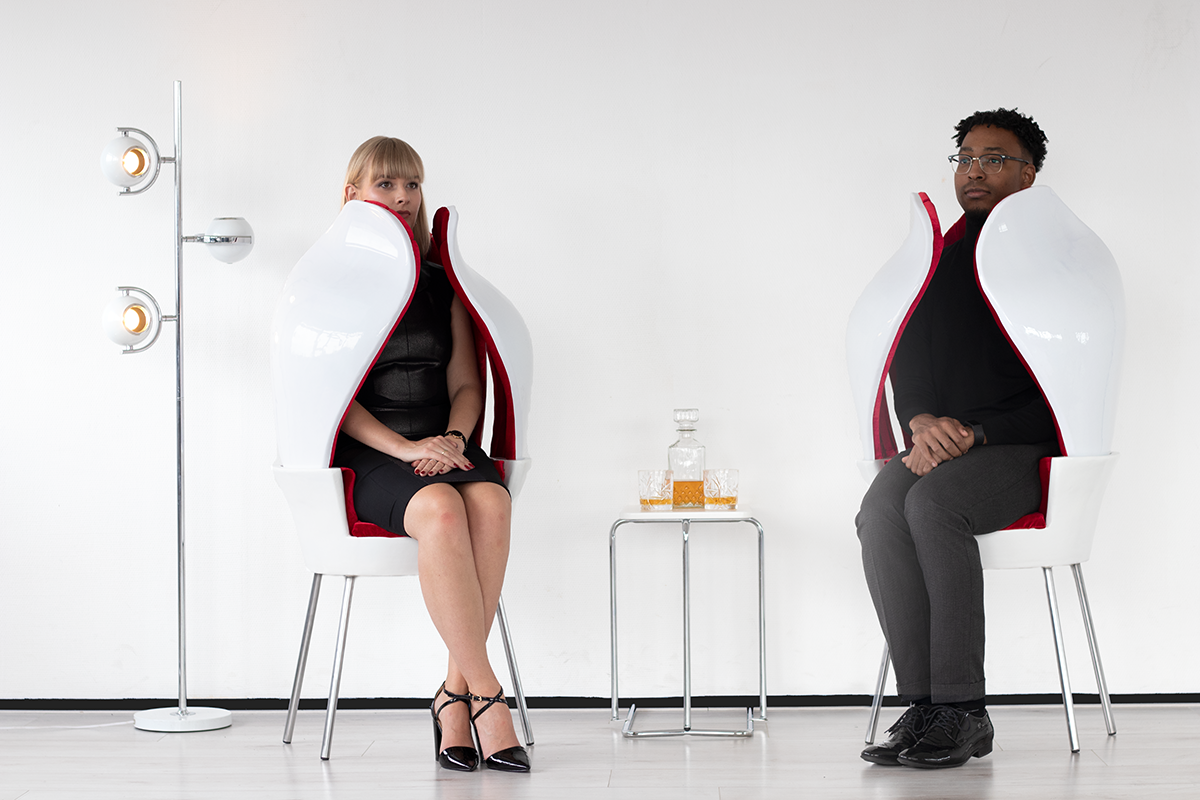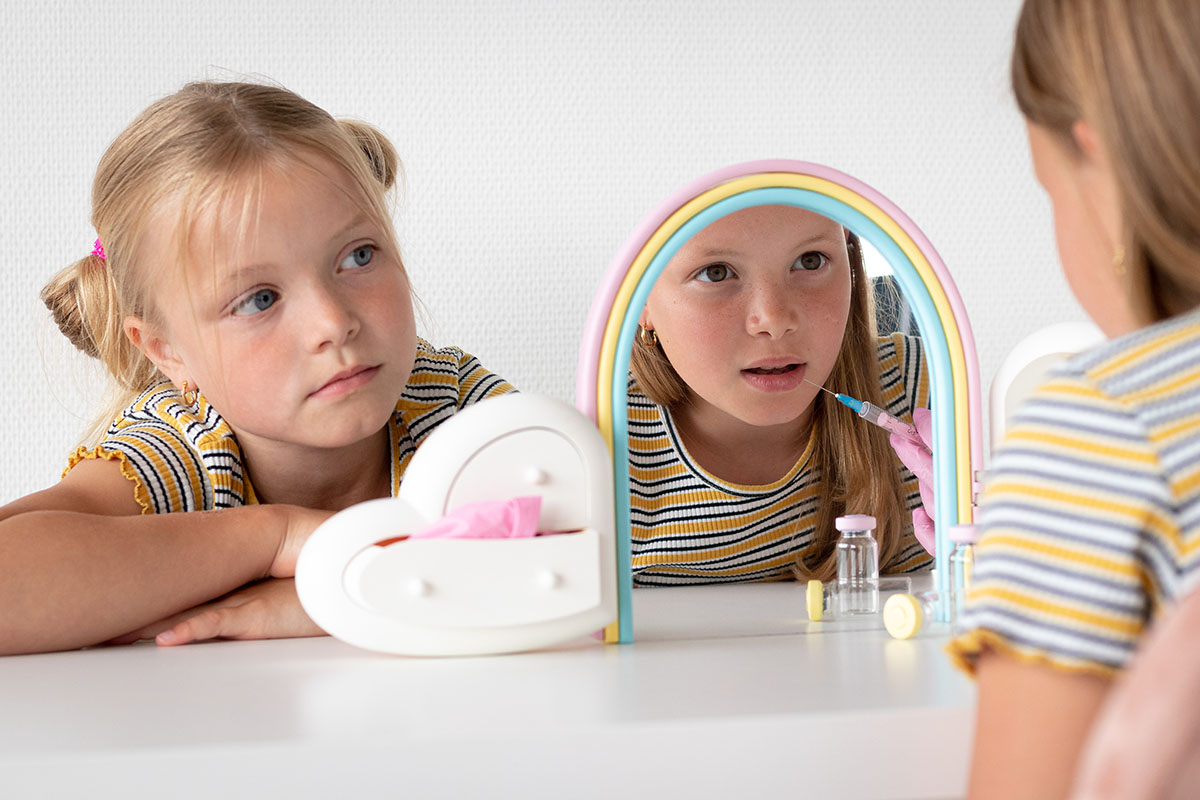By Joy van Gogh
Context
Factually, we have gotten more beautiful over the last decades, but the dissatisfaction about the way we look has never been bigger, states associate professor Liesbeth Woertman in her book De Psychologie van het Uiterlijk (2012). Recent studies from Dr. Decates at the Erasmus MC can back this up with numbers: injectable usage amongst 18 till 25 year olds has increased with 258% in the past ten years (Jeugd vaker aan de Botox, 2020). It seems as if beauty has become a thing to be good at or proud of, but what are the consequences our beauty-obsession has on our mental health, society or the future generations? The goal of this project was not to create products or services suited for the current market, but to create a series of critical designs that uncover the effects our obsession with beauty has on us.
During the analysis phase, the phenomenon Beauty Ideals was explored, as well as the psychological aspects such as self-image and social roles, resulting in six overarching themes. Three of these themes were chosen to design for. In order to create design for debate and awareness, critical design theory by Dune and Raby (2013) was applied to create three designs, which consist of a dystopia, a prototype and a scenario photo. The combination of these three, show the problems that could arise when we choose to beautify to an extent to which we can no longer return to natural.
Designs
The Wishbone

The Wishbone
Dystopia
In a future world the beauty ideal of ageless and untouched has reached a new level. Similar to your wedding china, facial muscles and facial expressions are used as little as possible in order to keep them from damaging. From an early age, preventive Botox is used by the public, in order to preserve the wrinkle-free, youthful faces. Due to this extensive Botox usage, expressing emotions, amongst which smiling, has become next to impossible. Smiling however is healthy and creates the production of the feel-good hormones dopamine and serotonin.
In this future scenario, smiling is not the norm, but the exception. In order to produce these feel-good hormones and wear a smile as accessory, a face jewel is designed. The jewel forces the facial muscles of the user into a smile, which creates both a smile as accessory as well as happy hormones. The jewel can be worn to celebrations and parties and makes sure that the user leaves the event looking and feeling her best!
The Tulip

The Tulip
Dystopia
We already live in a world where the way we beautify ourselves gets in the way of pleasant touch. Think of loads of make-up, hair products or extensions and in extreme cases plastic surgery, such as labiaplasty. All these ways to beautify ourselves, tell the other person to admire us at arm’s length, but not to touch. In combination with people getting more awkward and distant, due to the perfectly filtered social media images, a couple decennia from now people will have lost the desire and ability to touch and hug one another.
Touch, however, is the first sense that is developed in the womb and is healthy and necessary. Hugging releases hormones that reduce stress and anxiety and calm the nervous-system.
In order to fulfil this primal need for hugs and touch, a chair is designed. Instead of cuddling on the couch, users can climb into separate cocoons and fully immerse oneself into a womb-like experience, while still sitting together. The inside of the chair is inviting: it is soft, warm and has a sense of richness. Where the exterior of the chair is sending the message not to touch or come too close. While the body is immersed in this chair, your beautiful face is framed and still on display.
The Cloud

The Cloud
Dystopia
In a world, not far from now, women will try to live up to the expectations concerning their social roles to an extreme. The different social roles women fulfil, ask for different body images. Where a lover has to be sensual, a mother should be soft and a boss should look stern. They use injectables that work immediately, and will dissolve within a couple hours. They can subtly alter their appearance by applying the injectables themselves, just as one would apply make-up.
Since girls get their first period younger every decennium, they are welcomed into womanhood at an early age, varying from 8 till 12 years old. Since being a woman means living up to certain expectations, they get a special present when they get their first period: their own first injectables kit.
Conclusion
The designs above show a number of problems that may arise when we choose to beautify to an extent to which we can no longer return to natural. The combination of the dystopia with the designs, models and scenario photos show three problems that could arise if we do not interfere with current developments.
First of all, the Wishbone reflects how beautification affects our metal health. Often we beautify ourselves because we want to become happier, but research shows, that rarely ever this is the case. Short term happiness is achieved, but on the long run, on average, people become more discontent with themselves and the way they look. The design of the Wishbone reflects how we limit ourselves in the way we feel and express ourselves. Taking the current developments, such as preventive Botox, to an extreme, people will physically be unable to move their faces in a way that is healthy for both the brain and the body.
Secondly, the Tulip reflects how beautification affects our relationships. The way we want to make ourselves look better, stands in the way of pleasant touch and how we perceive touch. Again, taken to an extreme, we see that an extremely important part of human connection is limited, muted or avoided all together.
Furthermore, the Cloud reflects how beautification affects the generations to come. Having small amounts of Botox and fillers injected seems innocent, but do not forget that young children, are vulnerable and susceptible to everything they see around them. Especially when it comes to their direct environment. Using injectables as a mother, aunt, teacher or other type of role model, gives off a signal to the younger generation that they are not good enough the way they are.
The goal of the designs was never to force people to change their minds, but rather to create a healthy conversation about the topic. These dystopian designs left viewers with strong emotions that contributed to starting a conversation.
References
Dunne, A., & Raby, F. (2013). Speculative Everything: Design, Ficiton, and social dreaming. Cambridge, Massachusetts: the MIT press.
Kappé, S., & Nieuwenhuis, M. (2020, 1 juli). Jeugd veel vaker aan de botox. Geraadpleegd op 5 juli 2020, van https://www.ad.nl/gezond/jeugd-veel-vaker-aan-de-botox-effect-soms-desastreus-ik-schaam-me-nergens-voor~a3e7521a/
Woertman, L. (2012). Psychologie van het uiterlijk: tevreden met het uiterlijk, maar de imperfectie lokt. Amserdam: Pearson.



